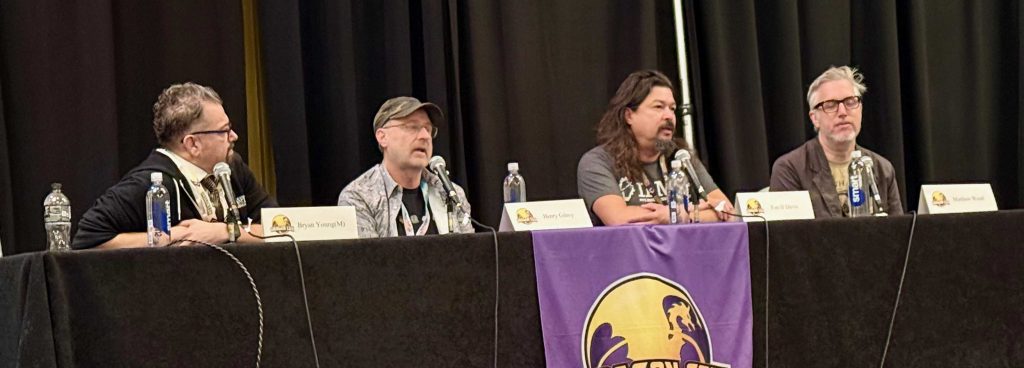The Star Wars track continued its strong run of panels Sunday afternoon at 1PM when it brought Matthew Wood, Fon Davis, and Henry Gilroy to the Hilton Grand West for a discussion of life as a member of Industrial Light and Magic (ILM). Moderated by Bryan Young, the panel took the audience on a fascinating journey into the world of a company that literally redefined what it means to make a film.

Fundamental to the conversation was the presence and importance of George Lucas. As an artist and creator, he built both the culture and company. His goal was to realize his vision, which in the 1970s meant constructing what he needed. Lucas will “go down as an innovator in cinema” Davis declared, literally developing the technology that came to drive the industry, including ILM, Skywalker Sound, motion capture, and so much more. It was Lucas who always pushed the technological envelope and insisted that his companies do the same. This idea of constant innovation and creation can be seen in the reference to ILM’s facilities as a “campus.” “It’s a bit like a university” Davis continued, in that the emphasis was always upon solving the problem, answering the question, and achieving the seemingly impossible.
ILM quickly became a dominant force in the film industry, at one point responsible for 75% of all special effects being produced. Under those circumstances, working as a team was essential. Wood reminded the audience that the work was “bigger than all of us” and it was important to realize the director or producer’s vision. Davis emphasized that under those challenging conditions, no one could afford to be afraid of failure, because failure was not an option. People could and did make lots of mistakes. Given the nature of the work, and the fact that every shop was constantly pushing the envelope, mistakes were going to occur. What a team member couldn’t do was allow a mistake to stop them. They had to keep going and learn the lessons the mistake had to teach.
Much has been written about ILM’s role in the development of computer graphics technology and Lucas’s own desire to move completely away from miniatures/models. Davis, whose career began in the model shop, has seen the documentaries describing the apprehension his predecessors and mentors felt as computer graphics assumed more of a role in film production. He feels that’s a bit overblown, pointing out that the one prequel film used more miniatures than the entire original trilogy combined. Eventually, his shop included more than one hundred model makers. The challenge wasn’t in finding them work to do but rather making sure that the artists were in the place and assigned the jobs that allowed them to do their best work. Even more, as a member of the next generation of artist, he had less fear of computer technology that his predecessors. He’d grown up with it and was naturally less anxious.
A little later in the panel Davis returned to the subject of technological innovation and practical effects. He admitted that his shop suffered from “Early Adopters Syndrome,” a condition in which they were always looking ahead and embracing new technology as soon as it appeared. The problem with that is that new tech is very expensive and tends to break! Davis found it interesting that with time a relationship developed between ILM and the companies producing the new technology. ILM artists were using (and breaking) the tech, essentially serving as lab testers for the software or equipment and in turn helping accelerate the pace of innovation. Toward the end of the hour Davis summed up the theme of the entire panel by describing a typical production meeting. The meeting occurred in a conference room. The various team leaders sat around the table in the middle of which was a speaker phone. Someone would press a button, and the project’s producer or director would be on the line outlining their vision and what needed to be created. After wrapping the conversation someone at the table pushed the button multiple times to make sure the call had ended. Then they’d look at one another and ask: “OK. How are we going to do this?” The question was never “can we do this?” It was always how. At the end of the day that “get it done” sensibility, rooted in Lucas’s vision, defined ILM, it’s culture and its legacy.
